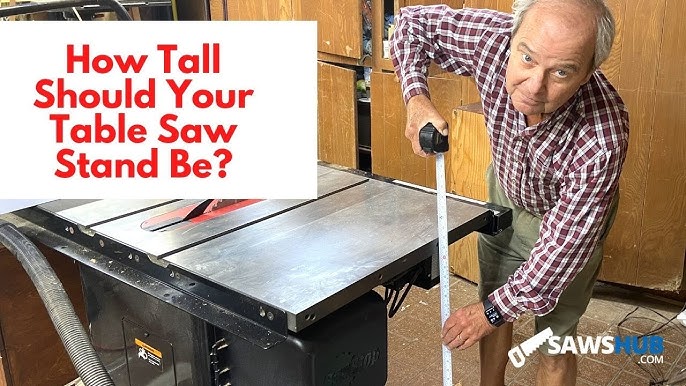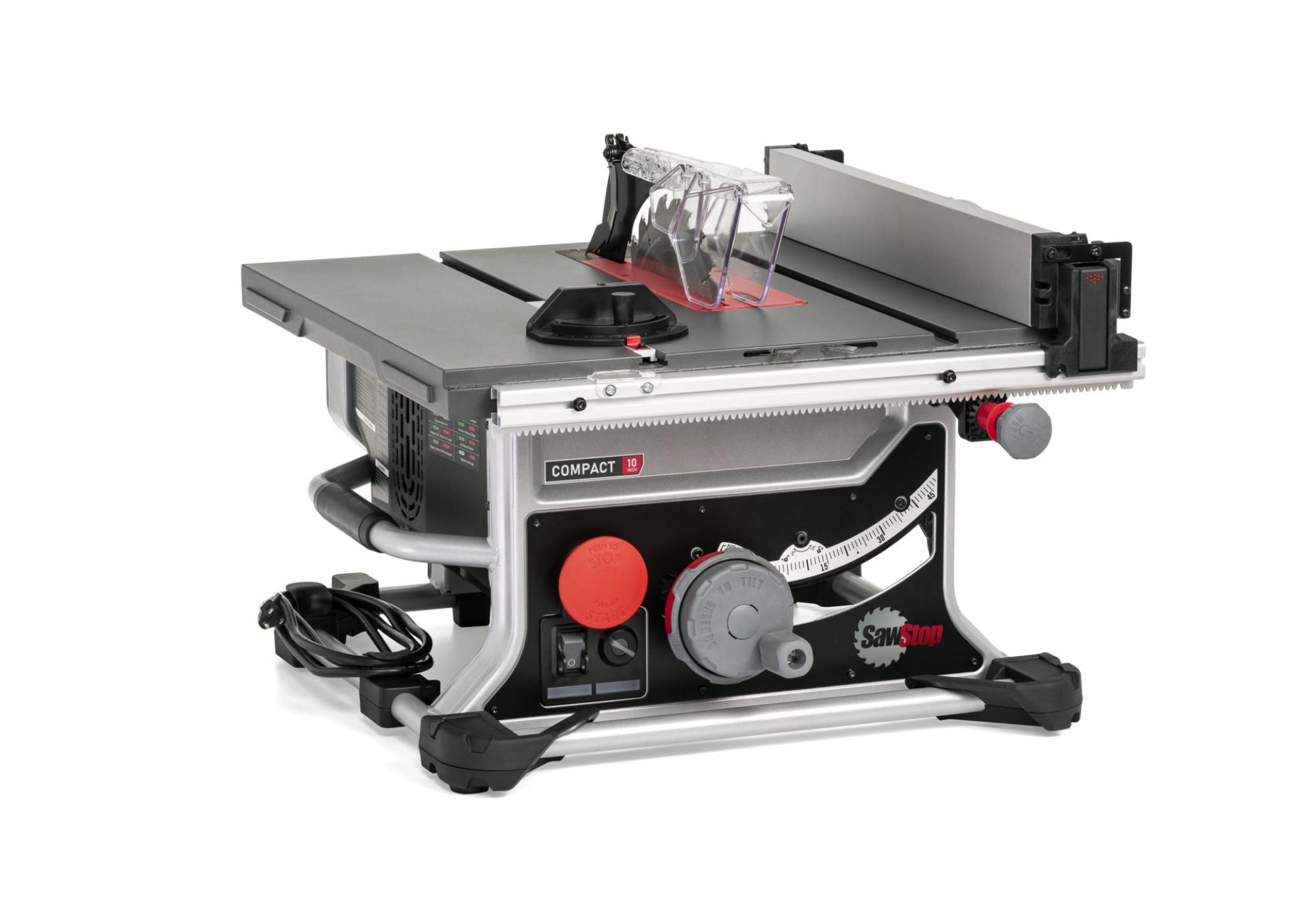Welcome to the fascinating world of table saws! Today, we’re going to tackle the question, “How tall are table saws?”
Picture this: you’re in your workshop, ready to embark on a woodworking adventure. You’ve got your materials prepped, your design in mind, and your table saw at the ready. But before you start, it’s essential to know the height of your trusty tool.
Whether you’re a seasoned woodworker or a curious beginner, understanding the height of table saws is crucial for safety and optimal performance. So, let’s dive in and discover the answer to this intriguing question together!

How Tall Are Table Saws? A Comprehensive Guide
Table saws are essential tools for any woodworking enthusiast or professional carpenter. They are versatile machines that can make precise cuts on various materials. One important aspect to consider when purchasing a table saw is its height. The height of a table saw can affect the comfort and safety of the user, as well as the quality of work produced. In this article, we will explore the different factors that determine the height of table saws and provide you with all the information you need to choose the right one for your needs.
1. Standard Table Saw Height
The standard height for most table saws is around 34 to 36 inches. This is the height at which the table saw is set up out of the box and is suitable for an average-sized adult. The goal is to have the work surface at a comfortable height so that the user can easily see and manipulate the material being cut. It is important to note that this height may not be ideal for everyone, as individual preferences and physical attributes may vary.
Some table saw manufacturers provide adjustable leg systems or stands that allow you to customize the height to your liking. This can be particularly useful for taller or shorter individuals, as well as those with specific ergonomic needs. Adjustable stands typically have a range of height adjustments, allowing you to find the perfect working height for your comfort and safety.
Benefits of Adjusting the Table Saw Height:
1. Improved Comfort: Adjusting the table saw height to your comfort level can help reduce strain and fatigue during long hours of use. This can make a significant difference in your productivity and overall enjoyment of woodworking.
2. Enhanced Safety: When your table saw is set at the right height, you can maintain proper posture and have better control over the material being cut. This can minimize the risk of accidents and ensure safer woodworking practices.
3. Precision and Accuracy: Working at the optimal height for your body can improve your ability to make precise cuts. This is particularly important when working on intricate projects that require a high level of accuracy.
2. Factors Affecting Table Saw Height
Various factors can influence the height of a table saw. Understanding these factors will help you make an informed decision when selecting a table saw or adjusting its height.
a) User’s Height:
The height of the user is a crucial factor to consider when determining the ideal height of a table saw. Taller individuals may need a higher working surface to maintain a comfortable stance and prevent bending over excessively. Conversely, shorter individuals may require a lower table saw height to achieve the same level of comfort and safety.
b) Type of Work:
The type of work you typically do with a table saw also plays a role in determining the height. For example, if you primarily work with large sheets of plywood, you may want a table saw with a higher height to accommodate the size of the material.
Conversely, if you often work on small, intricate projects, a lower table saw height may be more suitable, as it allows for better control and visibility.
c) Personal Preference:
Personal preference is another critical factor. Some individuals may simply prefer working at a higher or lower height based on what feels most comfortable to them. It is important to experiment and find the height that works best for you.
3. Adjusting the Table Saw Height
If you find that the standard height of your table saw is not suitable for your needs, you may need to make adjustments. Here are some ways to adjust the height of a table saw:
a) Adjustable Leg System:
Some table saws come with adjustable leg systems that allow you to raise or lower the table to your desired height. Follow the manufacturer’s instructions to make the necessary adjustments.
b) Build a Custom Table Saw Stand:
Another option is to build a custom table saw stand that matches your preferred height. This can be as simple as modifying the existing stand or building an entirely new one from scratch. Be sure to consider stability and safety when constructing a custom stand.
c) Use Table Saw Risers or Platforms:
Table saw risers or platforms can be added to the legs of the table saw to increase its overall height. These are typically adjustable and can provide the necessary elevation for taller individuals.
Remember to consider the stability and weight-bearing capacity of the table saw and any modifications made to it. Safety should always be a priority when adjusting the height of a table saw.
Table Saw Height: Key Considerations
Now that we’ve covered the basics of table saw height, let’s delve into some key considerations when selecting or adjusting the height of a table saw.
1. Safety
Table saw safety should be a primary concern. Ensure that the table saw is set at a height where you can comfortably maintain good posture and have clear visibility of the material being cut. This will minimize the risk of accidents and injuries.
2. Comfort
Working at the right height can significantly impact your comfort level when using a table saw. Make sure the table saw is set to a height that allows you to work for extended periods without straining your back or wrists.
3. Ergonomics
Consider your physical attributes and any specific ergonomic needs you may have. For example, if you have back problems, a height-adjustable table saw may be a better option for you.
4. Practicality
Think about the type of work you typically do with a table saw and choose a height that suits your specific needs. Consider the size of the material and any additional equipment or tools you may be using alongside the table saw.
Conclusion
The height of a table saw plays a significant role in comfort, safety, and overall productivity. Most table saws come with a standard height, but they can often be adjusted to accommodate individual preferences and physical attributes. By considering factors such as the user’s height, type of work, and personal preference, you can find or adjust the table saw height that best suits your needs. Remember to prioritize safety, comfort, and ergonomics when using a table saw, and always follow the manufacturer’s instructions for any adjustments.
Key Takeaways: How Tall Are Table Saws?
- Table saws come in different sizes and heights.
- The height of a table saw can range from 34 inches to 42 inches.
- The height of a table saw depends on the model and its purpose.
- The height of a table saw is designed for comfortable and ergonomic use.
- It’s important to consider your own height and working preferences when choosing a table saw.
Frequently Asked Questions
Welcome to our frequently asked questions section all about table saws! Below, you’ll find answers to some of the most common questions people have when it comes to the height of table saws. Whether you’re a beginner woodworker or a seasoned professional, understanding the height of table saws is an essential aspect of using these tools effectively and safely. Let’s dive in!
Q1: What is the average height of a table saw?
The average height of a table saw is around 34 inches. However, it’s important to note that table saw heights can vary depending on the model and brand. Some table saws may be slightly shorter or taller than the average, so it’s a good idea to check the specific measurements provided by the manufacturer.
Remember, the height of the table saw is designed to provide a comfortable working position for the user. It should allow you to stand straight without hunching over, reducing strain on your back and ensuring better control and accuracy while operating the saw.
Q2: Can the height of a table saw be adjusted?
Yes, the height of most table saws can be adjusted to suit your needs. Typically, this is accomplished by raising or lowering the blade and the table surface. The method of adjustment may vary depending on the specific model of the table saw.
Adjusting the height of your table saw is important for achieving the most comfortable and ergonomic working position for your specific needs. It allows you to customize the saw to your height, reducing the risk of strain or injury and improving overall efficiency in your work.
Q3: Are there any guidelines for choosing the right table saw height?
When choosing the right height for your table saw, there are a few guidelines you can follow. First, make sure the table saw is set at a height that allows you to stand comfortably without bending or stretching excessively. This will help prevent fatigue and strain on your body.
Additionally, consider the type of work you’ll be doing. If you’ll be primarily working with large or heavy materials, a slightly lower table saw height may provide more stability and better control. On the other hand, if you’ll be doing delicate or precision work, a slightly higher table saw height may be more suitable for enhanced visibility and control.
Q4: Can I use riser blocks to increase the height of my table saw?
Yes, some table saws can accommodate riser blocks, which are an accessory that can be used to increase the height of the saw. Riser blocks are typically installed between the table and the blade assembly, effectively raising the overall height of the saw.
However, it’s important to check the manufacturer’s guidelines before using riser blocks on your table saw. Not all table saw models are compatible or designed to use riser blocks. Additionally, make sure to follow the instructions provided by the manufacturer for proper installation and usage of riser blocks to ensure safety and optimal performance.
Q5: Are there any safety considerations regarding table saw height?
Ensuring the proper height of your table saw is not only important for comfort and ergonomics, but also for safety. When the table saw is set at the right height, you’ll have better control over the material being cut and reduce the risk of accidents.
Remember to always follow proper safety procedures when using a table saw, regardless of its height. This includes using safety equipment such as goggles and push sticks, maintaining a clean and clutter-free work area, and keeping your hands away from the blade. If you have any specific safety concerns or questions, consult the user manual of your table saw or seek guidance from a knowledgeable professional.

Summary
Table saws come in different sizes, but most are around 3 to 4 feet tall. However, there are smaller portable table saws that are closer to the height of a regular table. It’s important to consider the height of a table saw when using it to ensure safety and comfort.
Additionally, when choosing a table saw, you should also consider other factors like the power, blade size, and safety features. Table saws are a useful tool for woodworking, but it’s important to choose the right size and features for your needs.
